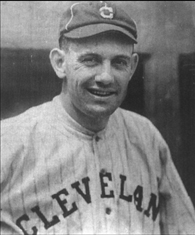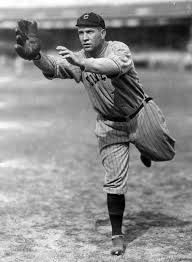|
Pivotal World Series Moments
Sewell Replaces Chapman
1920 World Series: Cleveland Indians vs Brooklyn Robins
Rules modifications before the 1920 season produced arguably the greatest changes in baseball's long history.
Both leagues adopted a ban on the spitball and all other "trick deliveries." That ended a period of 16-17 years in which ball-doctoring was fundamental to numerous hurlers' success. 17 spitballers were allowed to finish their careers throwing their favorite pitch, but no one else in Organized Baseball could legally tamper with the ball in any way. For the first few years, even applying rosin to the fingers was proscribed.
Owners also allowed spectators to keep balls hit into the stands, and umpires were instructed to discard scuffed and stained balls. As a result, batters in the post-World War I decade saw whiter, easier-to-see baseballs than in previous years.
The Spaulding company, the exclusive manufacturer of major league baseball and most minor leagues, would later admit that starting in 1920, they had begun using a higher-grade woolen yarn that wound tighter around the cork-rubber core of the ball. That made the balls more "lively" and brought an end to the "dead ball" era.
The result was the greatest boost in batting statistics since 1893 when the pitching distance was lengthened by 10'. In 1920, major league batters combined for 630 home runs, a huge increase over the 338 that had been hit in 1917, the last previous 154-game season.
A tragic incident on August 16, 1920, had a major impact on the pennant race and World Series.
The Cleveland Indians, leading the American League by 1/2 game over the Chicago White Sox, began a crucial three-game series against the New York Yankees at the Polo Grounds. The Indians led 3-0 in the top of the fifth against righthanded submarine hurler Carl Mays. Tragedy struck when one of Mays's underhand fast balls hit Cleveland SS Ray Chapman in the head. Chapman was taken to a hospital where it was determined that he had a fractured skull. Surgery was performed to relieve pressure on his brain, but he died early the next morning.
Cleveland player-manager Tris Speaker tried rookie Harry Lunte, who had only seven at-bats all season, at shortstop for 17 games. But Lunte hit only .203. When the rookie suffered a severe charley horse on Labor Day, Speaker had to turn to LF Joe Evans, a converted infielder who had played all of six games at shortstop in 1919.
Fortunately, in July the Indians had signed 5'8" Joey Sewell, the recently graduated shortstop from the University of Alabama. He had been shipped to Class A New Orleans to gain experience for 1921. Sewell joined the Indians four days after Lunte's injury and took over the shortstop position September 12.
A lefthanded batter, Sewell hit .329 in 22 games the rest of the season to help Cleveland win the American League pennant by two games over the White Sox. He wasn't the fielder that Chapman had been, committing 15 errors in 22 games, but who was?
Sewell Helps Indians Win Pennant
The day the World Series started, an article appeared in the New Orleans Times-Picayune in the city where Sewell played before joining the Indians.
Local color is injected in the world's series inasmuch as President A. J. Heinemann of the Pelicans was partially instrumental in assisting the Indians in attaining their goal. He sent Joe Sewell, the brilliant little shortstop, to Cleveland when the Speakerites were tottering under the strain of the final dash, and Joe came through handsomely. ...
Sewell's rise in baseball has been nothing short of sensational and is a record in the annals of baseball, according to Al Munro Elias, dean of baseball statisticians. ... He fit into the Cleveland lineup immediately. He has slugged the ball second only to the illustrious Tris Speaker, finishing the season with an average of .377 [sic] and a fielding average of .800. The Indians had to get permission from the Robins for Sewell to play in the World Series since he joined the team after the September 1 deadline. Brooklyn manager Wilbert Robinson waived the rule because of the special circumstances created by Chapman's death.
In the Series, which Cleveland won in seven games, Joe hit only .174 (4 for 23) and committed six errors, four more than any other player on either team. Not impressive numbers, but the Indians may not have reached the World Series without Sewell's contribution down the stretch.
Sewell manned the shortstop position for Cleveland through the 1930 season before playing three years with the Yankees. He compiled a .312 career batting average with a .391 on-base percentage. The Veterans' Committee selected him for the Hall of Fame in 1977.
Reference: John McGraw, Charles C. Alexander (1988)
|

 Ray Chapman
Ray Chapman
 Tris Speaker
Tris Speaker